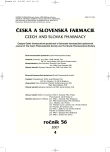A study of the properties of tablets from the mixtures of directly compressible starch and directly compressible lactitol
Authors:
J. Mužíková; J. Vajglová
Authors‘ workplace:
Hradec Králové, Czech Republic
; Department of Pharmaceutical Technology, Charles University in Prague, Faculty of Pharmacy in
Published in:
Čes. slov. Farm., 2007; 56, 183-189
Category:
Original Articles
Overview
The paper deals with the evaluation of tablets from the mixtures of directly compressible starch Starch 1500® and directly compressible lactitol Lacty®-Tab in a ratio of 3:1 and 1:1. The examination included the tensile strength and disintegration time of tablets in dependence on compression force, addition of two concentrations of sodium stearyl fumarate (Pruv) as the lubricant, and a 50% content of the model active ingredient acetylsalicylic acid. Tensile strength of tablets increased with compression force and the effect of Pruv decreased it in both mixtures. Tablets from the mixture of dry binders in a ratio 1:1 without the lubricant possessed highest values of tensile strength. After an addition of the lubricant, no statistically significant difference was found in this mixture between interventions of 0.5 and 1% Pruv concentrations into strength. Disintegration time increased with compression force; it was the shortest in tablets with 1% Pruv in the case of the mixture of Starch 1500 and lactitol 3:1; in the case of the mixture 1:1 it was the longest. Tablets containing acetylsalicylic acid possessed higher values of tensile strength in the case of the mixture of dry powders in a ratio of 1:1, the strength decreasing with increasing Pruv concentration. Tablets from this mixture also possessed a longer period of disintegration time which increased with increasing Pruv concentration.
Key words:
Starch 1500® – Lacty®-Tab – sodium stearyl fumarate – acetylsalicylic acid – tensile strength of tablets – disintegration time
Labels
Pharmacy Clinical pharmacologyArticle was published in
Czech and Slovak Pharmacy

2007 Issue 4
Most read in this issue
- Interactions of food and dietary supplements with drug metabolising cytochrome P450 enzymes
- Voltage gated calcium channels: structure, characteristics and terminology
- Applications of molecularly imprinted polymers in analytical and pharmaceutical chemistry
- The effect of polymeric dispersion type on the release of diclofenac sodium from coated pellets
